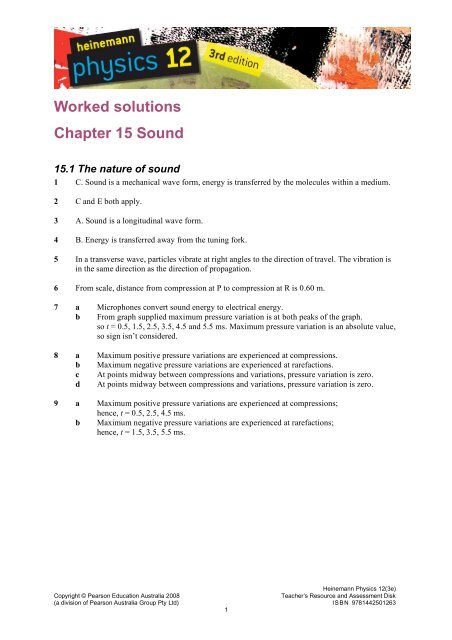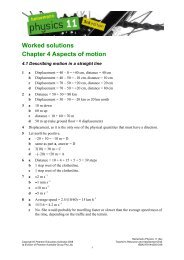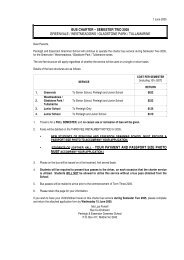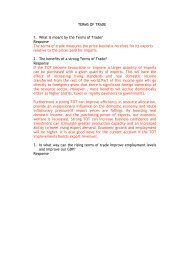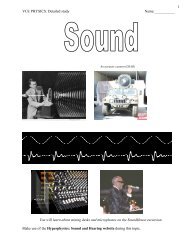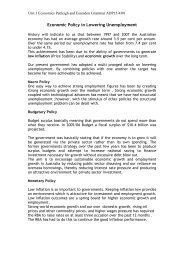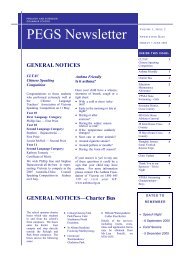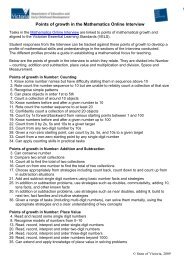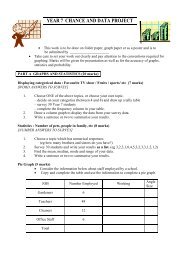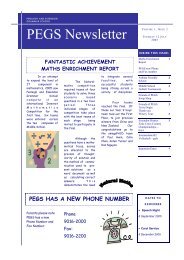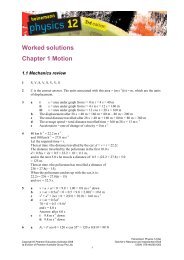Worked solutions Chapter 15 Sound - PEGSnet
Worked solutions Chapter 15 Sound - PEGSnet
Worked solutions Chapter 15 Sound - PEGSnet
Create successful ePaper yourself
Turn your PDF publications into a flip-book with our unique Google optimized e-Paper software.
<strong>Worked</strong> <strong>solutions</strong><br />
<strong>Chapter</strong> <strong>15</strong> <strong>Sound</strong><br />
<strong>15</strong>.1 The nature of sound<br />
1 C. <strong>Sound</strong> is a mechanical wave form, energy is transferred by the molecules within a medium.<br />
2 C and E both apply.<br />
3 A. <strong>Sound</strong> is a longitudinal wave form.<br />
4 B. Energy is transferred away from the tuning fork.<br />
5 In a transverse wave, particles vibrate at right angles to the direction of travel. The vibration is<br />
in the same direction as the direction of propagation.<br />
6 From scale, distance from compression at P to compression at R is 0.60 m.<br />
7 a Microphones convert sound energy to electrical energy.<br />
b From graph supplied maximum pressure variation is at both peaks of the graph.<br />
so t = 0.5, 1.5, 2.5, 3.5, 4.5 and 5.5 ms. Maximum pressure variation is an absolute value,<br />
so sign isn’t considered.<br />
8 a Maximum positive pressure variations are experienced at compressions.<br />
b Maximum negative pressure variations are experienced at rarefactions.<br />
c At points midway between compressions and variations, pressure variation is zero.<br />
d At points midway between compressions and variations, pressure variation is zero.<br />
9 a Maximum positive pressure variations are experienced at compressions;<br />
hence, t = 0.5, 2.5, 4.5 ms.<br />
b Maximum negative pressure variations are experienced at rarefactions;<br />
hence, t = 1.5, 3.5, 5.5 ms.<br />
Heinemann Physics 12(3e)<br />
Copyright © Pearson Education Australia 2008<br />
Teacher’s Resource and Assessment Disk<br />
(a division of Pearson Australia Group Pty Ltd) ISBN 9781442501263<br />
1
<strong>Worked</strong> <strong>solutions</strong><br />
<strong>Chapter</strong> <strong>15</strong> <strong>Sound</strong><br />
<strong>15</strong>.2 The wave equation<br />
1 C. The speed of sound is the speed at which energy is being transferred by the sound wave.<br />
2 There is a greater force of attraction between the molecules in water than those in air. When a<br />
water molecule is displaced, it thus returns to the mean position faster, transferring energy<br />
faster.<br />
3 C. A greater air temperature means a greater energy level overall.<br />
4 D is the best answer since amplitude is a measure of the energy. However, it could also be<br />
argued that as A, B and C are to a degree interdependent, the other choices are also correct.<br />
5 C. Amplitude is independent of the other quoted quantities.<br />
0.30<br />
6 See page 556 for relevant figures. v = d/t =<br />
3<br />
1"<br />
10 !<br />
= 300 m s –1<br />
7 t for sound to travel 20 m =<br />
Hence advantage = 0.059 s<br />
Moral—watch the gun!<br />
20<br />
340<br />
= 0.059 s, time for light to travel 10 m is negligible.<br />
8 Total time = 20 s = time for shell to travel to target plus time for sound to travel back.<br />
Time for sound to travel back = 3400 = 10 s; hence, time for shell to reach target = 10 s and<br />
340<br />
speed of the shell = 340 m s –1 .<br />
9 a v = f , hence = v/f = <strong>15</strong>00 = 1.5 m.<br />
1000<br />
b Total time = time to reach floor plus time to come back.<br />
Hence, time to floor = 1.0 s and distance = 1.0 × <strong>15</strong>00 = <strong>15</strong>00 m or 1.5 km.<br />
c The medium does not affect the frequency, hence ratio = 1:1.<br />
10 a = v/f = <strong>15</strong>00<br />
2000 = 0.75 m<br />
(Doubling frequency halves wavelength since f is inversely proportional to .)<br />
b The medium is unchanged. Hence, time remains the same.<br />
Heinemann Physics 12(3e)<br />
Copyright © Pearson Education Australia 2008<br />
Teacher’s Resource and Assessment Disk<br />
(a division of Pearson Australia Group Pty Ltd) ISBN 9781442501263<br />
2
<strong>Worked</strong> <strong>solutions</strong><br />
<strong>Chapter</strong> <strong>15</strong> <strong>Sound</strong><br />
<strong>15</strong>.3 Diffraction of sound<br />
1 = v/f = 340<br />
1000 = 0.34 m<br />
2 Since is approximately equal to w, appreciable diffraction occurs and the sound will spread to<br />
points P and R and also be heard at Q.<br />
3 = v/f =<br />
340<br />
4000 = 0.085 m<br />
4 is significantly smaller than w. Hence, less diffraction will occur.<br />
5 More of the sound energy travels directly to Q.<br />
6 B. An increase in amplitude means more energy overall, so an increase in intensity will be<br />
detected.<br />
7 D. With an increase in W, diffraction will decrease.<br />
8 High frequencies are diffracted less than low frequencies and, hence, are more directional.<br />
9 A. The wavelength of the sound from the double bass is longer; hence, will be diffracted more.<br />
10 Since the frequency of the violin is higher, the wavelength will be shorter. Less diffraction will<br />
occur, meaning that more of the available sound energy will reach the teacher at point Y.<br />
Heinemann Physics 12(3e)<br />
Copyright © Pearson Education Australia 2008<br />
Teacher’s Resource and Assessment Disk<br />
(a division of Pearson Australia Group Pty Ltd) ISBN 9781442501263<br />
3
<strong>Worked</strong> <strong>solutions</strong><br />
<strong>Chapter</strong> <strong>15</strong> <strong>Sound</strong><br />
<strong>15</strong>.4 Amplitude, intensity and the decibel scale<br />
1 D. Turning up the volume increases energy and therefore increases intensity. It has no effect on<br />
the other quantities.<br />
2 The frequency response of any two individual’s ears will be different and hence the individuals<br />
may differ on the subjective quantity of a sound’s loudness. This doesn’t mean the quantifiable<br />
energy level is different.<br />
3 E. Power output, distance, medium and prevailing conditions will affect the intensity of the<br />
sound received.<br />
4 a = 340 = 0.23 m or 23 cm<br />
<strong>15</strong>00<br />
b = 23 cm since the wavelength of the sound source won’t change. It is not dependent on<br />
the distance from the source.<br />
5 a Distance source to P = 1 m, to Q = 3 m.<br />
1<br />
Since I ∝<br />
2<br />
r , I = 1<br />
= 4.4 × 10 –3 W m –2<br />
2<br />
32" 4.0"<br />
10 !<br />
1<br />
b Distance is now 5 times original, so I =<br />
2<br />
52" 4.0"<br />
10 !<br />
= 1.6 × 10 –3 W m –2<br />
6 a<br />
1<br />
I = P/A =<br />
2<br />
4 ! ! ! r<br />
b<br />
1<br />
I = P/A =<br />
2<br />
4 ! ! ! r<br />
1<br />
=<br />
113 = 8.8 × 10–3 W m –2<br />
1<br />
=<br />
314.2 = 3.2 × 10–3 W m –2<br />
7 E = Pt = 1 × 10 = 10 J<br />
8 a Using L = 10 log I/I o where I o = 10 –12 W m –2 , and I = P/A = 7.9 × 10 –2 W m –2 , L = 109 dB<br />
b Using L = 10 log I/I o where I o = 10 –12 W m –2 , and I = 8.8 × 10 –3 W m –2 , L = 99 dB<br />
c Using L = 10 log I/I o where I o = 10 –12 W m –2 , and I = 1.6 × 10 –3 W m –2 , L = 95 dB<br />
9 a Using L = 10 log I/I o where I o = 10 –12 W m –2 , and L = 100 dB, I = 1.0 × 10 –2 W m –2<br />
1<br />
b At Q, I = = 1.1 × 10 –3 W m –2<br />
2<br />
32" 1.0"<br />
10 !<br />
c Using L = 10 log I/I o where I o = 10 –12 W m –2 , and I = 1.1 × 10 –3 W m –2 , L = 90 dB<br />
10 An decrease in sound level of 3 dB corresponds approximately to a halving of the sound<br />
intensity. 12 dB would therefore mean the sound intensity was halved 4 times, so<br />
I = 5.0 × 10 –10 × 24 = 8.0 × 10 –9 W m –2<br />
11 a<br />
1<br />
I = = 1.0 × 10 –5 W m –2<br />
2 3<br />
10 " 1.0"<br />
10 !<br />
b Using L = 10 log I/I o where I o = 10 –12 W m –2 , and I = 1.1 × 10 –5 W m –2 , L = 70 dB<br />
Heinemann Physics 12(3e)<br />
Copyright © Pearson Education Australia 2008<br />
Teacher’s Resource and Assessment Disk<br />
(a division of Pearson Australia Group Pty Ltd) ISBN 9781442501263<br />
4
<strong>Worked</strong> <strong>solutions</strong><br />
<strong>Chapter</strong> <strong>15</strong> <strong>Sound</strong><br />
<strong>15</strong>.5 Frequency, perceived loudness and the phon<br />
1 Frequency is determined by the source of the sound and is independent of the listener. Pitch is<br />
how the frequency of the sound is perceived by a particular listener.<br />
2 D. Average hearing for a young person is in the range of 20 Hz to 20 kHz.<br />
3 C. Hearing loss due to age is usually confined to higher frequencies.<br />
4 A is the better answer within the context of this question. Higher frequencies do carry more<br />
energy; hence, B is correct but not within the question’s context.<br />
5 Referring to the phon curves on page 574:<br />
a 0.2 kHz or 200 Hz<br />
b 0.1 kHz or 100 Hz<br />
c 0.05 kHz or 50 Hz<br />
6 Referring to the phon curves on page 574, i.e. 90 dB.<br />
7 Referring to the phon curves on page 574, i.e. 400–2000 Hz.<br />
8 C. Following the 60dB phon curve to where it intersects with a sound level of 80dB, i.e. 50Hz.<br />
9 a P = IA = 1.0 × 10 –8 W m –2 × (4 × π × 12) = 1.26 × 10 –7 W<br />
b From the phon curve I = 1000 × 10 –12 W m –2 or 1.0 × 10 –9 W m –2 .<br />
Using L = 10 log I/I o where I o = 10 –12 W m –2 , and I = 1.0 × 10 –5 W m –2 . L = 30 dB (based<br />
on the graph as printed. The published answer requires more careful scaling to achieve an<br />
answer of 25 dB.)<br />
10 At 10 kHz I = 10 –8 W m –2 , and at 2.0 kHz I = 10 –12 W m –2 .<br />
Using L = 10 log I/I o where I o = 10 –12 W m –2 , and I = 1.0 × 10 –8 W m –2 . L = 40 dB<br />
Heinemann Physics 12(3e)<br />
Copyright © Pearson Education Australia 2008<br />
Teacher’s Resource and Assessment Disk<br />
(a division of Pearson Australia Group Pty Ltd) ISBN 9781442501263<br />
5
<strong>Worked</strong> <strong>solutions</strong><br />
<strong>Chapter</strong> <strong>15</strong> <strong>Sound</strong><br />
<strong>15</strong>.6 Making sound: strings and air columns<br />
1 Refer to the theory of superposition of waves to confirm these answers.<br />
a true<br />
b false<br />
c true<br />
d false<br />
2 When the glass is exposed to a sound of the same resonant frequency as its natural frequency of<br />
vibration, resonance will occur. The amplitude of the vibrations will increase. If sufficient<br />
energy is available, the glass may shatter.<br />
3 The sound box of a guitar is tuned to resonate in the range of frequencies being produced by the<br />
guitar strings. Resonance within the sounding box amplifies the sound.<br />
4 A standing wave is produced as a result of the superposition of two waves of equal amplitude<br />
and frequency travelling in opposite directions in the same medium.<br />
5 a C. Refer to graphs page 586.<br />
b B. Refer to graphs page 586.<br />
c C. Refer to graphs page 586.<br />
6 a At the centre, i.e. L = / 2<br />
b At a point one-quarter of its length, i.e. L = / 4.<br />
c At a point one-sixth of its length, i.e. 2L = / 3 or / 6.<br />
7 a = 2L = 1.0 m, f = v/ = 300 Hz<br />
b f 2 = 2 × f 1 = 600 Hz<br />
c f 3 = 3 × f 1 = 900 Hz<br />
8 Resonance in air columns of a particular length is due to reflection of waves arriving at the ends<br />
of the column. The reflected waves are superimposed on the existing waves to produce a<br />
standing wave pattern. This results in resonance.<br />
9 a 1= 2L = 90 cm or 0.90 m<br />
b 2= 2L/2 = 45 cm or 0.45 m<br />
c 3= 2L/3 = 30 cm or 0.30 m, f = v/ = 330/0.30 = 1100 Hz or 1.1 kHz<br />
10 a f 1 = v/ = 330/2L = 110 Hz<br />
b f 3 = 3 × f 1 = 330 Hz<br />
c Only odd numbered harmonics are possible;<br />
so f 5 = 3 × f 1 = 550 Hz and f 7 = 3 × f 1 = 770 Hz<br />
Heinemann Physics 12(3e)<br />
Copyright © Pearson Education Australia 2008<br />
Teacher’s Resource and Assessment Disk<br />
(a division of Pearson Australia Group Pty Ltd) ISBN 9781442501263<br />
6
<strong>Worked</strong> <strong>solutions</strong><br />
<strong>Chapter</strong> <strong>15</strong> <strong>Sound</strong><br />
<strong>15</strong>.7 Recording and reproducing sound: the first and last links<br />
1 A moving coil loudspeaker typically uses a flexible cone to produce sounds, while a moving<br />
coil microphone uses a shielded diaphragm. The flat surface of the diaphragm provides a more<br />
reliable surface for converting sound waves to an electrical current.<br />
2 The larger the loudspeaker, the larger the cone and the more difficult it would be to make it<br />
vibrate with incident sound waves. Also, the 3D nature of the cone would make accurate<br />
reproduction of incident sound waves difficult. Thus a small, relatively flat cone—typical of<br />
small mid-range or tweeter speakers—would be the most suitable.<br />
3 The small, flat cone of a tweeter could not vibrate at the low speeds necessary to reproduce low<br />
frequencies reliably.<br />
4 Dropping the cone onto a bench would cause the coil of wire glued to the cone to move within<br />
the magnetic field of the magnet. An induced voltage would result and would be seen as a jump<br />
in the trace of an oscilloscope.<br />
5 A cylindrical magnet produces a strong radial field in the gap between north and south poles.<br />
The coil of the speaker vibrates within this field. The stronger the magnetic field, the higher—<br />
and therefore more distinct—the induced current/voltage.<br />
6 Their frequency range is too limited. (Carbon microphones cannot respond to frequencies above<br />
4 kHz.)<br />
7 The combined frequency responses of the different speakers need to cover the full range of<br />
frequencies audible to humans, while accurately producing particular small groups of<br />
frequencies.<br />
8 The electrodynamic, or moving coil, microphone provides the broad frequency response<br />
required for recording music.<br />
9 A small diaphragm is attached to a coil of wire. When sound energy is incident on the<br />
diaphragm, it moves up and down, moving the coil between the poles of a permanent magnet.<br />
This generates an induced voltage of varying frequency and amplitude in the coil, directly<br />
related to the variation in sound energy incident on the microphone’s diaphragm.<br />
10 As both microphones and loudspeakers convert one form of energy to another, both could be<br />
accurately described as transducers.<br />
Heinemann Physics 12(3e)<br />
Copyright © Pearson Education Australia 2008<br />
Teacher’s Resource and Assessment Disk<br />
(a division of Pearson Australia Group Pty Ltd) ISBN 9781442501263<br />
7
<strong>Worked</strong> <strong>solutions</strong><br />
<strong>Chapter</strong> <strong>15</strong> <strong>Sound</strong><br />
<strong>Chapter</strong> review<br />
1 C. Based on the graphs supplied pressure, variation is the best answer.<br />
2 B. From amplitudes of graphs supplied.<br />
3 C. From horizontal scale of graphs supplied.<br />
4 A. There is only one complete wave hence only one rarefaction.<br />
5 C. The graph of pressure variation has three positive peaks corresponding to three compressions<br />
(rarefactions are represented by negative peaks).<br />
6 A. Pressure variation is a maximum midway between a compression and rarefaction.<br />
7 C. One complete wave along the horizontal scale.<br />
.<br />
8 A. The wave is moving away from the source from left to right.<br />
9 D. From graph supplied.<br />
10 C. Speed is determined by the medium.<br />
11 Both C and D are correct.<br />
12 Using v = 340 m s –2 , f 1 = v/4L =<br />
13 f 3 = 3 × f 1 = 300 Hz<br />
340<br />
4!<br />
0.85<br />
= 100 Hz<br />
14 P = IA = 1.6 × 10 –6 W m –2 × (4 × π × 10 2 ) = 2.0 × 10 –3 W<br />
1<br />
<strong>15</strong> At 20 m the distance is doubled so I =<br />
6<br />
22" 1.6"<br />
10 !<br />
W m –2 = 4.0 × 10 –7 W m –2<br />
16 E = Pt = 2.0 × 10 –3 W × 60 × 10 = 1.2 J<br />
17 Intensity of sound is a measurable quantity (units W m –2 ), while the loudness of a sound<br />
depends on how a particular individual’s ears respond to that sound and can vary with frequency<br />
for each individual.<br />
18 An increase of 3.0 dB in sound level represents a doubling in sound intensity. Prolonged<br />
exposure to this increased level could cause problems.<br />
19 Most participants will report the greatest differences in perceived loudness at frequencies below<br />
500 Hz and above 5.0 kHz, i.e. at the lower and upper limits of average human hearing range.<br />
20 A tweeter best produces frequencies between 4 and 20 kHz. It would distort sounds, and test<br />
results, for frequencies significantly below 4 kHz. For best results, a broad range speaker with a<br />
flat frequency response curve for frequencies between 20 Hz and 20 kHz (the range of normal<br />
human hearing) would be required.<br />
Heinemann Physics 12(3e)<br />
Copyright © Pearson Education Australia 2008<br />
Teacher’s Resource and Assessment Disk<br />
(a division of Pearson Australia Group Pty Ltd) ISBN 9781442501263<br />
8
<strong>Worked</strong> <strong>solutions</strong><br />
<strong>Chapter</strong> <strong>15</strong> <strong>Sound</strong><br />
21 Baffling reduces, but rarely eliminates, reflections of sound waves that are created by the<br />
movement of the back surface of a loudspeaker’s cone. If not reduced, these sound waves would<br />
be superimposed on the sound waves from the front of the speaker cone to cancel out, or reduce,<br />
some frequencies.<br />
22 Electret-condensor. Mobile phones need to reliably reproduce the frequency range of the human<br />
voice—generally below 1 kHz. The microphone also needs to be compact and durable. The<br />
small capsule, low cost and durability of an electret-condensor microphone would be a good<br />
option. Its poor response to high frequencies would not be a drawback for this application.<br />
Heinemann Physics 12(3e)<br />
Copyright © Pearson Education Australia 2008<br />
Teacher’s Resource and Assessment Disk<br />
(a division of Pearson Australia Group Pty Ltd) ISBN 9781442501263<br />
9


